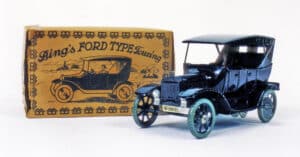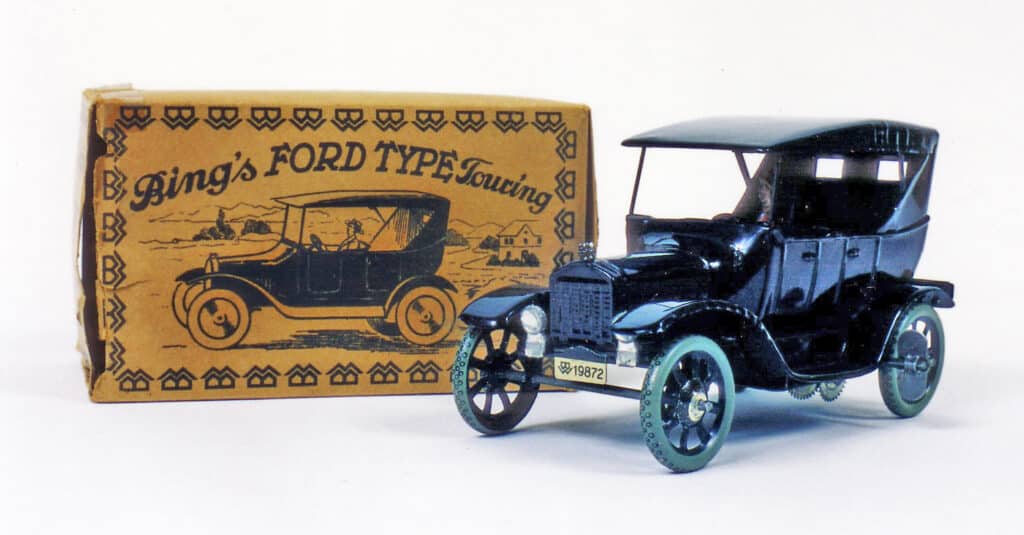by Douglas R. Kelly

Most people familiar with automotive history know that Henry Ford’s Model T put America on wheels. In fact, the T changed the course of history, being the first automobile to be built using true assembly line production processes when it was introduced in 1908. As time went on, Ford actually reduced the price of the Model T, due to increased efficiencies in the production of the car; this drove sales higher and higher, and Ford produced something like 15 million of the things before the Model T was phased out in 1927.
But there were very few miniature Model T’s, not even a handful of toys, made during the actual car’s lifetime. This doesn’t add up, to my way of thinking; seems to me that toy makers would line up to have a chance to produce toys of the most popular car on the roads. The Moline Pressed Steel Company did produce a 12-inch, more or less, Model T in pressed steel during the 1920s, as a part of its “Buddy L” line of toys. Finding these today isn’t easy and even battered examples sell for substantial dollars.
Strangely, it took a German toy manufacturer to give kids (and parents) an affordable model of the American success story. Gebrüder Bing, based in Nuremberg, Germany, had been making toys since the 1860s, and in the early 1920s, the company started producing a series of toy Model T’s that combined the play value of a toy with decent, model-like accuracy. That kind of realism is difficult (often impossible) to achieve with the tinplate sheet stock that Bing used for these toys, and it’s a constraint that was later avoided by the makers of Corgis, Dinkys, Tootsietoys, and so forth, which were made of diecast metal.
Four Versions

Bing offered the tinplate T in four body styles, all in the range of 6.5 inches in length, and each was a well-made toy that featured a clockwork motor. But they also had tinplate wheels, which of course offered little traction on tabletops and hardwood floors. The key for the clockwork motor was attached to a metal rod that protruded from beneath the running board on the driver’s side of the toy. And, Bing made the front axle adjustable, so the car could run in a circle as well as straight ahead.
In terms of colors, Bing followed Henry Ford’s lead, offering only black models until Ford changed its color policy during the last year or two of the Model T production run. Most surviving Bings are all black; those with the original red or blue paint are considered more valuable than the standard black examples. The Coupe was probably Bing’s most basic of the four body styles, with its two doors and boxy, upright look. Like the real coupe, Bing’s version came with “suicide” style doors (with the hinge at the rear of the door); this despite Ford giving the real Model T standard doors later in the production run. The Roadster could be called the sports car of the lineup, or as close to it as a Model T ever got. It actually was more show than go, given the T’s comparatively low-power engine, but the Bing version at least sported a “pebbled” roof.
The Touring Car sported a gently curving roof that had a pebbled finish, mimicking the leather-covered top on the real touring car. Bing called the last body style a Sedan, although some might call it an early station wagon. It was a boxy, squared-off design and was based on Ford’s “Fordor” model and featured the same suicide-type doors as the Coupe. All four body styles apparently came with both male and female drivers.
Incredibly 1920s
For toys that are now 90 years old, Bing Model T’s are not particularly rare. They’re just so incredibly 1920s, and are accurate models for their era. But check for originality. A Bing can be repainted, and there are producers of replacement parts out there, some of which are well-made and tough to tell from originals. Original condition (excellent or better) examples usually sell for $350 to $450. That’s for the standard black versions. If the original box is present, add $100 to $200 to the price. For colors other than black, I’d expect to see a price tag in the range of $750-$1,000 (again, for an original example in excellent condition).
Douglas R. Kelly is the editor of Marine Technology magazine. His byline has appeared in Antiques Roadshow Insider; Back Issue; Diecast Collector; RetroFan; and Buildings magazines.





Related posts: